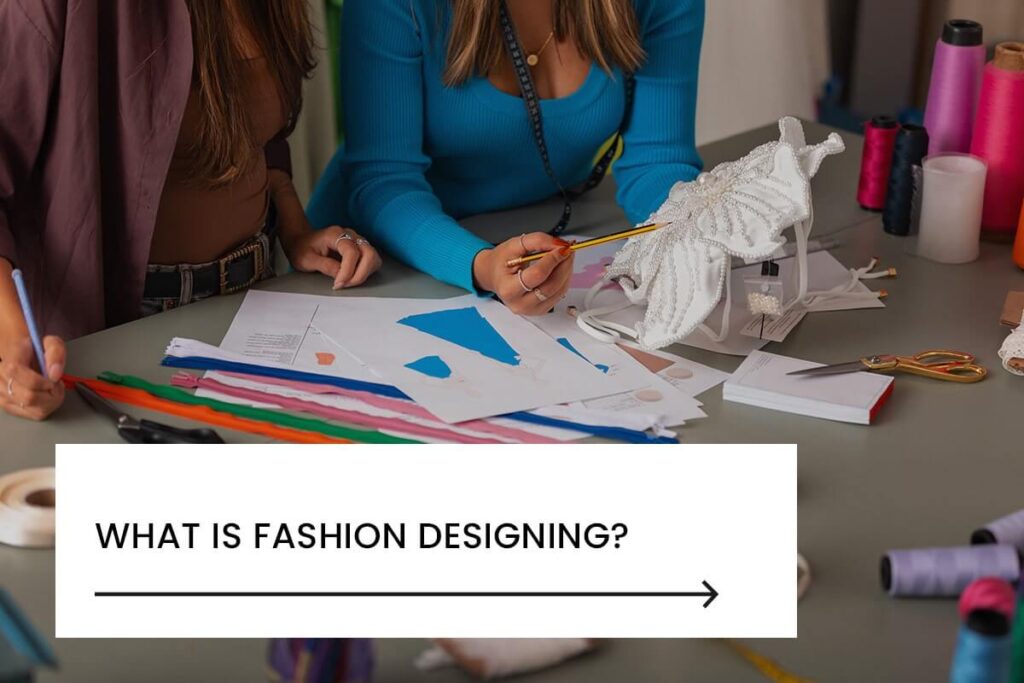Introduction:
Fashion designing is this wild, ever-shifting world where you take your craziest ideas and turn them into clothes and accessories people can’t wait to wear. It’s about blending raw creativity with the real stuff, fabrics, cuts, and what’s currently in style to create pieces that exude culture, personality, or just a vibe. If you’re obsessed with creating, a gig in fashion design lets you start trends, tell stories through outfits, and even change how people show up in the world style-wise. Curious about what fashion design is all about? Maybe you’re scoping out fashion design programs or want the scoop? This guide breaks down what fashion design is, its roots, the day-to-day activities of designers, the various paths you can take, the skills required to succeed, career options, and what’s on the horizon. Let’s dive into why fashion design is such a thrilling, all-in kind of career.
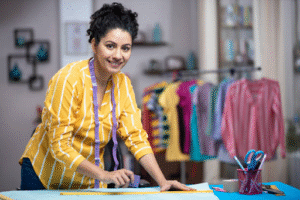
How Fashion Designing Provides a Unique Platform for Self-Expression
Fashion is a strong means of self-expression. As a fashion designer, you have the power to express messages, sentiments, and cultural stories through your designs. Every collection you design tells a story, expresses your aesthetic, and speaks to your fans. This capacity to inspire and influence with design is a major driving force for potential designers.
This blog delves into the essence of fashion while reaching out to the history of fashion up to the present-day fashion. It provides an insight into the numerous crucial parameters of fashion, i.e., creativity, technical competency, industry awareness, and career options. It also provides a peek into the life of fashion legend Charles Frederick Worth. It discusses how fashion has evolved over the decades and what the future holds.
What is Fashion Designing?
Fashion design is the conceptualization and development of clothing, accessories, and footwear. Apparel refers to clothing or wear that is donned. Occasionally, it describes a particular kind of clothing, like work or formal wear. The general populace may assume that fashion design will not have any relevance to their daily existence. Nevertheless, each piece of clothing was created by an individual, regardless of where the clothing or accessories were bought.
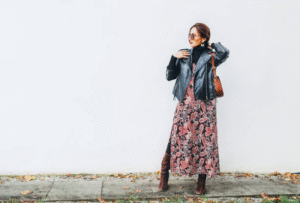
The Origins of Fashion Design
Fashion design’s got a wild history that goes way back to ancient times. Picture ancient Egypt, where what you wore was basically a flex of how rich you were, or the Greeks and Romans rocking those loose, flowing garments that had this effortless cool vibe. Fast forward to the Middle Ages and Renaissance, and clothes got fancier, more tailored, practically shouting your social status to anyone who looked. Then, in the 1800s, Charles Frederick Worth came along and basically invented high fashion, setting up the first fashion houses and starting those seasonal runway shows we’re still obsessed with. The 20th century was a whole vibe, think Coco Chanel dropping her sleek, no-drama looks, or the Roaring Twenties’ flapper dresses that were all about breaking the mold. Now, with global influences, cultural shifts, and tech in the mix, fashion design (even if some folks typo it as “fashon design”) is this electric, always-moving world that’s constantly got something fresh to throw at us.
Evolution into Contemporary Fashion
As centuries passed, fashion evolved with cultural shifts, especially during the Medieval and Renaissance periods, where garments grew more structured and ornate. The 19th century marked the birth of haute couture with Charles Frederick Worth, ushering in the era of custom fashion houses and seasonal collections. By the 20th century, the fashion world was more accessible and dynamic, informed by international happenings, social upheaval, and great designers, creating the multifaceted, trend-based industry we have today.
Fashion Designing vs. Fashion Styling: Know the Difference
The fundamental, most critical difference between a fashion stylist and a fashion designer is that the designer creates and makes clothes as well as possible. The stylist dresses and prepares the client for the occasion with clothes and accessories.
While the two job roles need an exact sense of fashion and trends, the career profile for a fashion designer necessitates a very technical sense of fashion, trends, sustainable material practices, and manufacturing.
The fashion designers and the fashion stylists both had a new future created by the skills and industries in the fashion industry. Fashion designers produce fashion in all ways. With their knowledge of consumers and the market environment, the style collection of the fashion designer is prepared and then purchased and enjoyed by the market or clients.
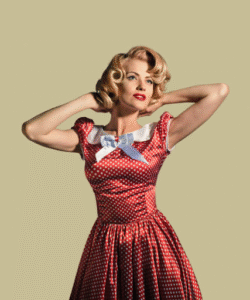
The Role of a Fashion Designer in the Industry
The position of a fashion designer is at the forefront of the world of fashion design, where innovation comes face to face with skills. From sketching initial ideas to overseeing the final touches on a fashion line, designers shape the trends and fashions that define every season. Their skill powers the vibrant and constantly evolving world of fashion.
The fashion designers have a key role in the success of a specific dress or fashion concept. They are involved in each process and step of the creation of an outfit, from its concept to designing and creating to selling it. The following are some key jobs and duties of a designer:
- Design and sketch out attire to define the work of all involved.
- Oversees the entire process, from conception to finished product and production.
- Select the right material and raw materials required for embellishment.
- Collaborate with other fashion designers to determine the right themes for the season.
- Develop new ideas and outlines, and make adjustments to the collection
- Oversee each process and step to ensure it runs as planned and according to the company’s objectives and goals.
- Collaborate with a technical designer to ensure all designs are right as planned.
- Check the product in terms of design, style, and fit, and present it to the stakeholders.
- Present the story behind the product, mood, and shade boards to higher management and buyers.
- Help the marketing team develop strategies
Different Types of Fashion Design
- Haute Couture: Upscale, bespoke fashion designed for specific clients with the utmost craftsmanship. It’s usually bespoke and exclusive, reflecting the ultimate in design and luxury.
- Luxury Fashion: This consists of high-end, high-profile brands that are renowned for their superior craftsmanship, superior materials, and exclusivity. These brands tend to make trends and have a high price tag.
- Ready-to-Wear Fashion: “prêt-à-porter” is mass-produced clothing in standard sizes that can be easily found in stores. It’s cheaper and created for the masses.
- Economy Fashion: This fashion type is cheap, affordable clothing made to be worn every day. Its accessibility, minimalism define it, and usually mirrors what’s popular now.
- Fast Fashion: This industry specializes in the fast production of cheap clothing to replicate current trends spotted on runways or among high-end fashion. It is characterized by quick style turnover and low cost.
- Streetwear & Contemporary Fashion: Streetwear incorporates city culture with statement fashion, based on skate, hip-hop, and youth subcultures. It feeds on uniqueness, small drops, and logo-normed constructions. Today’s fashion, however, merges contemporary looks with practicality and artistry. Both represent changing lifestyles, self-expressionism, and cultural reflection.
- Costume Design for Film & Theatre: Costume design is a strong narrative device that animates characters on screen and stage. It expresses periods, personality, and emotional journeys in fabric, texture, and silhouette. Costumes amplify visual storytelling and engage audiences more deeply in film and theater. Each piece plays a role—from dramatic effect to period detail.
Each type caters to different consumer needs, preferences, and price ranges, contributing to the diverse landscape of the fashion industry.
Skills Every Fashion Designer Needs
Fashion design combines artistic and technical abilities to design fashionable, high-quality garments. The majority of designers take fashion design at the bachelor’s level, and some pursue a master’s for higher-level skills.
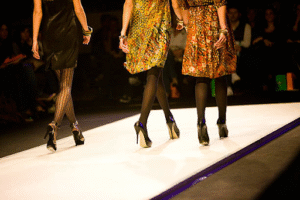
Important Skills in Fashion Design
1. Tools & Technology:
- Sketchpads & pencils: For rough design sketches and idea formulation.
- Sewing machines: Necessary for sewing fabric into finished garments.
- CAD software: Used to create digital 3D models to see designs.
- AR/VR: Supports virtual try-ons and interactive preview of designs.
- PLM tools: Coordinate the entire design process, from concept to manufacturing.
- Social media and e-commerce: Ideal for marketing and selling designs on the internet.
2. Fashion Theory & History:
- Fashion evolution: Know how fashion styles have evolved over time and between cultures.
- Cultural influence: Know how trends mirror social, political, and economic change.
- Design elements: Apply color, material, shape, and texture to develop original styles.
- Self-expression: Create clothing that expresses identity and contemporary lifestyles.
How to Become a Fashion Designer
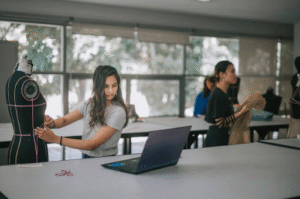
1) Why Choose Fashion Design?
Fashion is a rapidly expanding international industry that has numerous career paths. If you’re detail-conscious, creative, and fashion-conscious, a career in fashion design might be for you. Upon completion of 12th grade, you will usually require a fashion design degree or diploma, along with a portfolio, an entrance test, and internship experience.
2) Qualifications Required
While creativity is essential, formal training is beneficial. Choices include:
- Diploma: Essential skills and introduction to the fashion industry
- Bachelor’s Degree: Detailed understanding and practical training
- Master’s Degree: Bachelor-level expertise and improved job opportunities. Full-fledged fashion colleges in Delhi and India provide all three.
3) Eligibility criteria
- Diploma/Bachelor’s: 10+2 in any stream with 50% marks
- Master’s: Bachelor’s degree (any stream, fashion preferred), 50% marks
Check college-specific requirements before enrolling.
4) Fees
Program fees differ by college and course:
- Diploma: ₹50,000 per year (approx.)
- Master’s: ₹70,000 per year (approx.)
Fees vary depending on faculty, infrastructure, and facilities.
5) Course Curriculum
Fashion courses cover:
Textile design, pattern making, sketching, CAD, garment construction, fashion marketing, retail management, quality control, etc.
Extras are workshops, seminars, industry visits, and internships.
6) Job Opportunities
Career positions include:
Fashion designer, fashion consultant, costume designer, marketer, footwear/jewelry designer, fabric artist, and so on.
7) Top Employers in India
Fashion designers are recruited by companies like Sabyasachi, Biba, Fabindia, Aditya Birla Fashion, H&M, Marks & Spencer, Bata, Nike, Raymond, Reliance Trends, Woodland, and so on.
Building Your Career: Portfolio, Networking, and Opportunities
Your portfolio is like your resume on steroids. Pack it with sketches, finished outfits, and fresh ideas. Rub elbows with classmates, crash fashion shows, and snag internships at places like Sabyasachi or Nike to grow your circle. After fashion design, career options are wide open:
-
Designer, stylist, or advisor gigs.
-
Specializing in textiles, shoes, or jewelry.
-
Going solo with your brand.
-
Jobs at worldwide companies like H&M or even in virtual fashion for games.
With India’s fashion program worth a whopping $24 billion, there’s tons of room to grow.
Top Fashion Challenges Facing the Industry in 2025

1. Sustainability & Greenwashing
Fashion continues to be a heavy polluter and contributor to global carbon output, as well as textile waste. Consumers are demanding actual change, not greenwash “eco-friendly” marketing. Brands need to implement sustainable materials, provide supply chain transparency, and steer clear of greenwashing by supporting assertions with measurable data. Anything less risks eroding consumer trust.
2. Supply Chain Disruptions
Sustained global uncertainties such as inflation and climate change continue to disturb fashion supply chains. Fashion companies require more nimble systems, nearer manufacturing locations, and technologies such as AI and blockchain to monitor and respond to these disturbances on time.
3. Value-Driven Fashion
Consumers are valuing affordability, quality, and durability more than perpetual trends. This trend drives growth in resale markets, off-price stores, and dupes. Brands have to rationalize their prices and emphasize durable, functional designs in order to remain valid.
4. Cybersecurity Threats
As fashion becomes digital, cyber threats rise. Data breaches can harm a reputation and cost millions. Brands need to invest in effective cybersecurity systems, employee education, and data security measures.
5. Inclusivity & Diversity
People demand representation in terms of body type, race, and gender. Brands need to increase size ranges, recruit talent from diverse backgrounds, and show true-world diversity in their campaigns and company culture.
6. E-Commerce Returns
Fit problems and try-before-you-buy behavior fuel high return rates in clothing. Technology solutions such as virtual try-ons, AI sizing, and more accurate product information can minimize this issue.
7. Textile Waste
Only less than 1% of apparel is recycled. Brands need to implement circular models, employ biodegradable materials, and inform customers to minimize fashion waste.
8. Digital Transformation
AI, AR, and 3D technologies are simplifying design, manufacturing, and shopping. Brands embracing technology are becoming fast, efficient, and sustainable.
9. Talent Acquisition
Brands need to provide equitable compensation, career opportunities, and diversity-friendly environments to lure talent. Good culture drives innovation and engagement.
10. Consumer Trust
Skepticism is rampant. Brands need to be transparent, truthful, and supported by third-party validations to establish enduring trust.
5 Simple Tips for Aspiring Fashion Designers
You don’t have to go to fashion school to be a successful designer. Here are five tips from designer Marc Jacobs to get you started:
- Master the Basics – Sew, create patterns, and learn about fabrics. Practice works best when you’re working with your hands.
- Study the Legends – Learn from the best designers such as Coco Chanel, YSL, and Vivienne Westwood. Fashion tends to go around in circles, so understanding the past will make you an innovator.
- Experiment with Different Styles – Practice designing for other markets—sportswear, bridal, casual—until you discover your niche. Experimenting helps you find out what fits.
- Find Your Voice Naturally – Don’t worry if you don’t have a signature style immediately. Let it emerge over time as you work.
- Get Inspired by Life – Observe what people wear, jot down ideas, and take pictures. Good design inspiration can come from anywhere.
Technology Confronts Textiles: Fashion Design’s Future
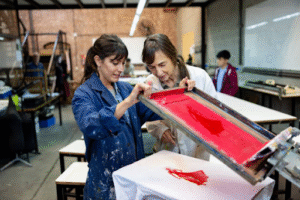
Fashion is being revolutionized by technology in a number of innovative ways. From intelligent textiles to 3D printing, innovation is transforming the way we design, produce, and dress.
Smart Textiles, such as temperature-controlling jackets and heart-rate-monitoring tops, are revolutionizing day-to-day fashion. Such clothes employ built-in tech to make clothes smarter and more practical.
Computer-aided 3D design software and digital clothing enable designers to design virtual clothes and use avatars rather than physical models, making it quicker and more environmentally friendly. 3D printing enables complete customization with minimal waste of material.
Artificial intelligence (AI) is now being used to facilitate computer-aided design, forecast trends, and personalize each customer’s style. Augmented reality (AR) improves shopping, enabling users to try on clothes virtually and designers to conduct interactive shows.
Fashion is also becoming greener, with the help of biotech cloth and environmentally friendly production techniques. But designers need to think about ethical issues, like the privacy of data in intelligent clothing and the treatment of employees.
Conclusion
Fashion designing is much more than just creating beautiful garments—it is a journey of passion, creativity, and continuous evolution. Throughout this blog, we’ve explored how fashion has grown from ancient cultural expressions to a multifaceted global industry influenced by technology, sustainability, and consumer values. From haute couture to streetwear, fashion offers a wide canvas for designers to experiment, innovate, and make meaningful statements.
We’ve also witnessed how fashion design unites artistry with technical proficiency, ranging from drawing and sewing to working with cutting-edge technology such as CAD, AR/VR, and AI. Regardless of whether you’re designing ready-to-wear collections, costume pieces, or high-fashion, there are many career options available in the industry. The path to becoming a successful fashion designer may start with a formal education, but it is experience gained in the real world, a stellar portfolio, and professional contacts that define your career.
The issues to come—such as sustainability, digital innovation, and inclusivity—are forcing designers to be different, act responsibly, and constantly innovate. But this is precisely what makes fashion design so thrilling today. It’s no longer simply a matter of copying trends, but creating them with purpose, intent, and truth.
FAQs
1. What does fashion design mean?
Fashion design is basically creating clothes and accessories that mix creativity, usefulness, and what’s hot in culture.
2. What does a fashion designer do?
They dream up sketches, choose fabrics, manage making the stuff, and help set trends with fresh collections.
3. What do I need to study to be a fashion designer?
It is generally required to have at least a diploma or a bachelor’s degree in fashion design or a related course. Most of the top colleges also insist that you clear an entrance exam and present a portfolio of your work. Though formal education is helpful, hands-on experience, originality, and a good portfolio are equally crucial.
4. Is fashion design a lucrative profession to pursue in India?
Yes, fashion design is an emerging and vibrant profession to pursue in India. As local and international brands, e-commerce websites, and personal style are on the rise, talented designers find good opportunities. Career options include working for fashion boutiques and movie productions, to starting your label or working on a freelance basis.
5. What are some fashion design examples?
Think Dior’s fancy gowns, Zara’s everyday lines, or Stella McCartney’s earth-friendly outfits.
6. What skills are required for a fashion designer?
A successful fashion designer requires a balance of technical and creative skills, including: Sketching and illustration
- Sewing and pattern making
- Knowledge of fabrics
- CAD software proficiency
- Analysis of trends
- Communication and business acumen
7. What are the eligibility criteria for fashion design courses?
High school done with 50% for basics; a bachelor’s for advanced. Might need tests or a portfolio.
8. Is it possible to be a fashion designer without holding a degree?
Yes, whereas a degree provides you with formal learning and credibility, it is indeed possible to be a fashion designer through self-education, apprenticeships, and having a powerful portfolio. A lot of famous designers are self-taught, but hard work, networking, and hands-on ability are essential.
9. What are the principal career routes after studying fashion design?
Fashion design graduates can go on to become:
- Fashion Designer
- Fashion Stylist
- Costume Designer
- Textile Designer
- Fashion Illustrator
- Merchandiser or Fashion Buyer
- Entrepreneur (starting your brand)
The fashion world presents varied functions in design, manufacturing, promotion, and sales.

